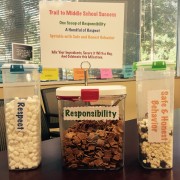Proactive Steps for Transitioning within or between Schools

For parents with school-aged children, the idea of transitioning with or between entirely new schools can be anxiety-producing. How will my child handle the change of environment, schedule, routine and peers? How can I get a head start on making the transition as smooth as possible? What if things do not go smoothly? Who can I turn to for guidance? All of these questions are not only typical, but valid as well. Below are suggestions and ideas for parents whose children are transferring to a different school, or who will be experiencing a major transition within the current school.
Attitude is everything: For children who are just beginning preschool, Pre-K, or kindergarten, the initial transition from home life to school life can be challenging on many different levels. To ease the process right from the start, parents should be cognizant of how they react to the transition, as well as deliberate in how they portray their own attitude towards school. Parents and older siblings should intentionally speak of school as a positive, exciting new experience. A positive attitude towards school promotes the idea that this is a beneficial change in the child’s life—it allows young children to become excited about the “newness” of the experience, as opposed to becoming frightened of the unknown. Discuss some of the new things that he or she will get to learn and participate in. Talk about the new friends they will make. Shed plenty of light on the great adventures that school provides—perhaps start a countdown to encourage excitement about the transition, instead of dread.
Even for older students, attitude is completely contagious. If children and teens sense stress or anxiety coming from you about the school changes, they are certainly more likely to internalize those emotions. Therefore, if your middle or high schooler is experiencing a transfer or major schedule change, their first line of support and initial dose of positivity should come from you, the parents. Validate their concerns by listening and not dismissing their feelings, but be ready to put a positive spin on their concerns and provide solutions to their perceived worries.
Do your research: To remove the intimidating shroud of the unknown, encourage any orientation, meet-and-greet, playdate, school tour, or mentorship that the new school might offer. For older students, check to see if their clubs, organizations, or extracurricular activities from the previous school exist at the new school. If so, get a jumpstart on registration, forms, and physicals for athletics. If your child or teen functions best when they know what is coming down the pike, ask the school about seeing your child’s class schedule or possibly meeting teachers in advance of the start date.
Guidance counselors are always a go-to for parent support, but networking through the PTA is another great resource. Members of the PTA are obviously involved in the school and in tune with the goings on in the school community. Fundraisers, parent meetings, and social events provide an opportunity for new parents to get involved, ask questions, and thus provide a sense of comfort to their child as “the new kid.” As much as information is power, parents new to a school’s community should be somewhat wary of the rumor mill, as this can paint facets of the school in a negative or incorrect light. Remember that any sort of listserv, blog post, or review could be biased or wholly untrue.
Focus on what’s important: Especially for middle and high schoolers, a transfer or transition to another program or school can mean a sharp learning curve, or even an initial decline in grades. Remind your student that anything new or unfamiliar is going to present its share of challenges, but this should not create discouragement. If grades slip or stress builds, reinforce your teen’s sense of self-worth by placing the focus on their other strengths. Remind him or her that a grade is simply one measure of their learning—it is not indicative of one’s intelligence or capabilities.
Set aside time to acknowledge small wins or slight victories as a means of boosting self-esteem. Remind your child of the potential for growth that comes with challenges and obstacles. Then, encourage your teen to put the emphasis on gradual growth and improvement—not a solitary grade or score.







